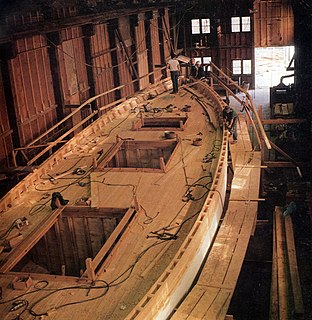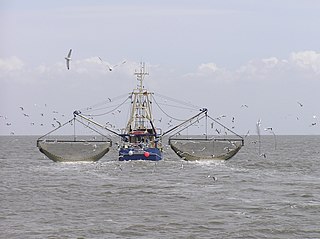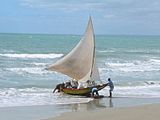
A dory is a small, shallow-draft boat, about 5 to 7 metres or 16 to 23 feet long. It is usually a lightweight boat with high sides, a flat bottom and sharp bows. They are easy to build because of their simple lines. For centuries, dories have been used as traditional fishing boats, both in coastal waters and in the open sea.

A dinghy is a type of small boat, often carried or towed by a larger vessel for use as a lifeboat or tender. Utility dinghies are usually rowboats or have an outboard motor. Some are rigged for sailing but they differ from sailing dinghies, which are designed first and foremost for sailing. A dinghy's main use is for transfers from larger boats, especially when the larger boat cannot dock at a suitably-sized port or marina.

A coracle is a small, rounded, lightweight boat of the sort traditionally used in Wales, and also in parts of the West Country and in Ireland, particularly the River Boyne, and in Scotland, particularly the River Spey. The word is also used of similar boats found in India, Vietnam, Iraq and Tibet. The word "coracle" is an English spelling of the original Welsh cwrwgl, cognate with Irish and Scottish Gaelic currach, and is recorded in English text as early as the sixteenth century. Other historical English spellings include corougle, corracle, curricle and coricle.

Boat building is the design and construction of boats and their systems. This includes at a minimum a hull, with propulsion, mechanical, navigation, safety and other systems as a craft requires.

Planing is the mode of operation for a waterborne craft in which its weight is predominantly supported by hydrodynamic lift, rather than hydrostatic lift (buoyancy).
The Swampscott dory is a traditional fishing boat, used during the middle of the 19th century by fishing villages along the North Shore coast of Massachusetts centered on Swampscott. It is designed to be launched off the beach. Dories were generally built by the fisherman themselves in the off season and later by more organized boatyards. The rounded hull provides more buoyancy for launching through surf than the slab sided banks dory. The flat bottom allows the boat to sit upright on the beach. The lack of a keel keeps the boat from being grabbed by a wave and allows the boat to pass cleanly through the surf. The boat still heels easily which allows large fish to be rolled into the boat vs having to lift the fish completely up over the gunnel. The Swampscott Dory, a fishing boat still in use throughout the world today, was invented in 1840 by Theophilius Brackett to row and to pull lobster pots. The dory was considered the best seaworthy boat for fishermen due to its unique flat-bottomed design.
The Banks dory, or Grand Banks dory, is a type of dory. They were used as traditional fishing boats from the 1850s on the Grand Banks of Newfoundland. The Banks dory is a small, open, narrow, flat-bottomed and slab-sided boat with a particularly narrow transom. They were inexpensive to build and could be stacked or nested inside each other and stored on the decks of larger fishing vessels which functioned as mother ships.
The Jersey Skiff is a beach launched boat first appearing around the end of the 19th century. They were first used as fishing boats, to be launched through the surf, sailed to the fishing grounds and then retrieved through the surf.

A Drift Boat is an evolution of the open-water dory, converted for use in rivers. The design is characterized by a wide, flat bottom, flared sides, a narrow, flat bow, and a pointed stern. A Rocker is used along an arc from bow to stern along the bottom of the boat. It is this constant rocker that allows the boat to spin about its center for ease in maneuvering in rapids.

Sharpies are a type of hard chined sailboat with a flat bottom, extremely shallow draft, centreboards and straight, flaring sides. They are believed to have originated in the New Haven, Connecticut region of Long Island Sound, United States. They were traditional fishing boats used for oystering, and later appeared in other areas. With centerboards and shallow balanced rudders they are well suited to sailing in shallow tidal waters.

Philip C. Bolger was a prolific American boat designer, who was born and lived in Gloucester, Massachusetts. He began work full-time as a draftsman for boat designers Lindsay Lord and then John Hacker in the early 1950s.

A fishing vessel is a boat or ship used to catch fish in the sea, or on a lake or river. Many different kinds of vessels are used in commercial, artisanal and recreational fishing.

Lowell's Boat Shop is a National Historic Landmark at 459 Main Street in Amesbury, Massachusetts.

Traditionally, many different kinds of boats have been used as fishing boats to catch fish in the sea, or on a lake or river. Even today, many traditional fishing boats are still in use. According to the United Nations Food and Agriculture Organization (FAO), at the end of 2004, the world fishing fleet consisted of about 4 million vessels, of which 2.7 million were undecked (open) boats. While nearly all decked vessels were mechanised, only one-third of the undecked fishing boats were powered, usually with outboard engines. The remaining 1.8 million boats were traditional craft of various types, operated by sail and oars.
John Gardner (1905–1995) born in Calais, Maine, USA; was a historian of water craft, a writer, a labor organizer, and a designer and builder of wooden boats.

The McKenzie River dory, or drift boat, is an adaptation of the open-water dory converted for use in rivers. A variant of the boat's hull is called a modified McKenzie dory or Rogue River dory. The McKenzie designs are characterized by a wide, flat bottom, flared sides, a narrow, flat bow, and a pointed stern. The sole identifying characteristic of the McKenzie River dory is a continuous rocker. It is this constant rocker that allows the boat to spin about its center for ease in maneuvering in rapids.

Human-powered watercraft are watercraft propelled by human power.

The Buccaneer 200 is an American trailerable sailboat, that was designed by Alan Payne and first built in 1974. The boat was built by Bayliner Marine Corporation in the United States, but it is now out of production.

The D. J. Lawlor was a 19th-century Sandy Hook pilot boat built in 1881. The schooner was considered the largest for her type, noted for her seaworthiness and heavy weather performance. She was named after the prominent Boston shipbuilder Dennison J. Lawlor. She was struck by a fishing schooner Horace B. Parker, in 1895, and was replaced by the pilot-boat Liberty in 1896.
















